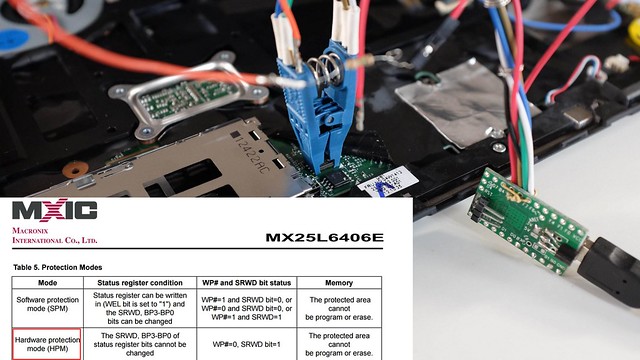mirror of
https://github.com/linuxboot/heads.git
synced 2025-01-18 10:46:44 +00:00
coreboot.org gets redirected to www.coreboot.org. ``` $ curl -I https://coreboot.org HTTP/1.1 301 Moved Permanently Server: nginx/1.8.1 Date: Mon, 06 Mar 2017 12:59:27 GMT Content-Type: text/html Content-Length: 184 Connection: keep-alive Location: https://www.coreboot.org/ ``` So save a request, and use the final URL.
108 lines
4.3 KiB
Markdown
108 lines
4.3 KiB
Markdown

|
|
|
|
Heads: the other side of TAILS
|
|
===
|
|
|
|
Heads is a configuration for laptops that tries to bring more security
|
|
to commodity hardware. Among its goals are:
|
|
|
|
* Use free software on the boot path
|
|
* Move the root of trust into hardware (or at least the ROM bootblock)
|
|
* Measure and attest to the state of the firmware
|
|
* Measure and verify all filesystems
|
|
|
|

|
|
|
|
NOTE: It is a work in progress and not yet ready for non-technical users.
|
|
If you're interested in contributing, please get in touch.
|
|
Installation requires disassembly of your laptop or server,
|
|
external SPI flash programmers, possible risk of destruction and
|
|
significant frustration.
|
|
|
|
More information is available in [the 33C3 presentation of building "Slightly more secure systems"](https://trmm.net/Heads_33c3).
|
|
|
|
|
|
Building heads
|
|
===
|
|
|
|
In order to build reproducible firmware images, Heads builds a specific
|
|
version of gcc and uses it to compile the Linux kernel and various tools
|
|
that go into the initrd. Unfortunately this means the first step is a
|
|
little slow since it will clone the `musl-cross` tree and build gcc...
|
|
|
|
Once that is done, the top level `Makefile` will handle most of the
|
|
remaining details -- it downloads the various packages, verifies the
|
|
hashes, applies Heads specific patches, configures and builds them
|
|
with the cross compiler, and then copies the necessary parts into
|
|
the `initrd` directory.
|
|
|
|
There are still dependencies on the build system's coreutils in
|
|
`/bin` and `/usr/bin/`, but any problems should be detectable if you
|
|
end up with a different hash than the official builds.
|
|
|
|
The various components that are downloaded are in the `./modules`
|
|
directory and include:
|
|
|
|
* [musl-libc](https://www.musl-libc.org/)
|
|
* [busybox](https://busybox.net/)
|
|
* [kexec](https://wiki.archlinux.org/index.php/kexec)
|
|
* [mbedtls](https://tls.mbed.org/)
|
|
* [tpmtotp](https://trmm.net/Tpmtotp)
|
|
* [coreboot](https://www.coreboot.org/)
|
|
* [cryptsetup](https://gitlab.com/cryptsetup/cryptsetup)
|
|
* [lvm2](https://sourceware.org/lvm2/)
|
|
* [gnupg](https://www.gnupg.org/)
|
|
* [Linux kernel](https://kernel.org)
|
|
* [Xen hypervisor](https://www.xenproject.org/)
|
|
|
|
We also recommend installing [Qubes OS](https://www.qubes-os.org/),
|
|
although there Heads can `kexec` into any (?) Linux or
|
|
[multiboot](https://www.gnu.org/software/grub/manual/multiboot/multiboot.html)
|
|
kernel.
|
|
|
|
Notes:
|
|
---
|
|
|
|
* Building coreboot's cross compilers can take a while. Luckily this is only done once.
|
|
* Builds are finally reproducible! The [reproduciblebuilds tag](https://github.com/osresearch/heads/issues?q=is%3Aopen+is%3Aissue+milestone%3Areproduciblebuilds) tracks any regressions.
|
|
* Currently only tested in QEMU, the Thinkpad x230 and the Chell chromebook.
|
|
** Xen and the TPM do not work in QEMU, so it is only for testing the `initrd` image.
|
|
* Booting Qubes requires patching Xen's real mode startup code
|
|
see `patches/xen-4.6.3.patch` and adding `no-real-mode` to start
|
|
of the Xen command line. Booting or installing Qubes is a bit hacky and needs to be documented.
|
|
|
|
|
|
Signing with GPG
|
|
---
|
|
`gpgv` is a stripped down version of GPG that can be used to verify
|
|
signatures without extraneous libraries. This works well with the
|
|
Free Software workflow that we want to use.
|
|
|
|
gpg --clearsign roothash
|
|
|
|
The `roothash` and `roothash.sig` files can be embedded into the
|
|
HDD image and then extracted at firmware boot time:
|
|
|
|
gpgv --keyring /trustedkeys.gpg roothash.sig roothash \
|
|
|| echo "FAILED"
|
|
|
|
The `mount-boot` script is a start at doing this automatically.
|
|
There needs to be an empty block at the end of the partition
|
|
that includes a signed script to be executed; typically it will
|
|
contain the dm-verity parameters to build the `dmsetup` command
|
|
line to mount `/boot`.
|
|
|
|
The boot script can't be stored in the boot filesystem since the
|
|
dm-verity hashes that protect the filesystem would need to have their
|
|
own hash pre-computed, which is not feasible with a good hashing
|
|
algorithm. You could store the hashes in the ROM, but that would
|
|
not allow upgrades without rewriting the ROM.
|
|
|
|
|
|
coreboot console messages
|
|
---
|
|
The coreboot console messages are stored in the CBMEM region
|
|
and can be read by the Linux payload with the `cbmem --console | less`
|
|
command. There is lots of interesting data about the state of the
|
|
system.
|